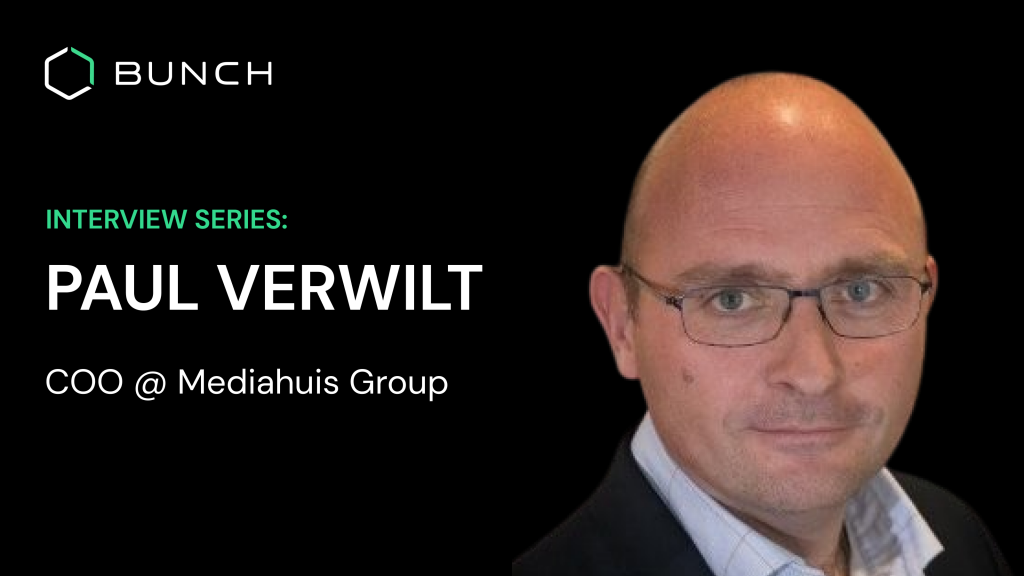
Leadership is evolving. The skills required for successful leadership today will differ in five years.
Paul Verwilt
In this edition of our new Leadership Development Interview Series, we sat down with Paul Verwilt to learn about how MediaHuis (MediaHouse in English) – a multinational publishing business- is approaching the topic of leadership during a period of rapid change as they reinvent their business model for a digital world.
Paul, can you tell us a bit about yourself?
Well, I’m part of the executive team at MediaHouse, alongside our CEO and CFO. My role as the Chief Operating Officer has evolved significantly over the last 10 years. Initially, I was more of a traditional COO, focusing on people, processes, technology, and industry. But as the company grew, my responsibilities expanded. Now, I handle technology for the group, our business in Germany, our venturing business, and our marketplaces in real estate, jobs, cars, and business comparison. Additionally, I’m involved in our 2030 strategic plan, as we transition to full digital. We work as a three-person team to run the company, splitting responsibilities to make it manageable. Media House Group has approximately 4,500 colleagues, a revenue of 1.2 billion euros, and an operational result of around 160 million over the last few years.
What are the current top 1-2 pain points when it comes to people, culture, and teams?
The biggest challenge is our transition from a newspaper company to a fully digital media company. This change requires a shift in how our business operates and the technological skills our people need. We’re still figuring out a sustainable digital business model. Leadership has also evolved. It used to be top-down, but now it’s changing, which is challenging for those who grew up in a different era. We have a relatively older management team, and in the next 12-15 years, most of them will be retiring. Succession planning and adapting leadership styles to a digital, fast-paced environment are significant challenges.
Why is this an issue, you think?
People’s attitudes towards change haven’t shifted much. Some are resistant to change, while others thrive on it. The middle group is neither against change nor entirely comfortable with it. New tools, working with new colleagues, or adapting to increased diversity can cause discomfort. Our transformation into a multinational company also brings cultural differences that can be challenging for employees. So, the crux of the issue lies in creating the right context and supporting people through these changes.
What have you tried to resolve/tackle?
We focus on clarifying our future direction and linking it to our mission and vision. Acknowledging that doubts and failures are normal is also crucial. We create a supportive environment where change is normal, and we provide help through training, mentoring, and more. We also encourage collaboration and working together on these changes. This approach involves a mix of internal teams and external partners, like consultants, for specific needs.
What does leadership mean to you, and which skills do people need to succeed as a leader?
Leadership is evolving. The skills required for successful leadership today will differ in five years. Currently, accountability is key, especially because of our CEO-focused structure. However, in the future, adaptability, flexibility, visionary thinking, and emotional intelligence will be more crucial. The challenge lies in transitioning from our current leadership style to one that suits a fast-paced, digital world.
What does leadership development look like at your company? Which tools and programs do you have in place, and how do you currently select new leadership talent to develop?
We focus on strategic and visionary thinking, especially for those coming from operational roles. Collaboration and working in a diverse world are also important, considering our local roots and transition to a multinational company. The nature of collaboration is changing, requiring adaptation. We work on individual needs as well, supported by both internal resources and external partners. Assessment tools are frequently used to understand individual development needs.
What are some current challenges with leadership development overall in your company?
The most significant challenge is fostering true collaboration, where shared goals are prioritized over individual territories. As we evolve, leadership roles are becoming less about individual territory and more about collaborative efforts. This shift is cultural and requires a different approach to working together.
Have you considered using AI tools in developing the future generation of leaders? Why/why not?
Our experience with AI in training and development is mostly indirect, through partners. We’ve observed substantial work in content generation for training purposes using AI, like large language models. There’s also a growing emphasis on understanding how to use AI tools effectively in business. Some AI applications we’ve seen include training people on feedback mechanisms, using voice recognition and pattern recognition to improve interactions. However, our direct involvement with AI in training and development is limited.
What applications of AI seem most promising to you from a leadership development standpoint? Where does AI fall flat?
AI shows promise in content generation for training and in simulating real-world scenarios for skill development, like giving feedback. The ability of AI to bring cost-effectiveness and quality to training is significant. However, the human element is still crucial in understanding and interpreting complex human interactions and cultural nuances, areas where AI may not be fully effective yet.
To learn from more experts on how to grow leaders at your company, check out our full list of interviews here.
If you’re looking to grow future leaders at your own company, get in touch to see how Bunch can enable you to give every person in your company a personalized, continuous development program in just 2 minutes a day.





